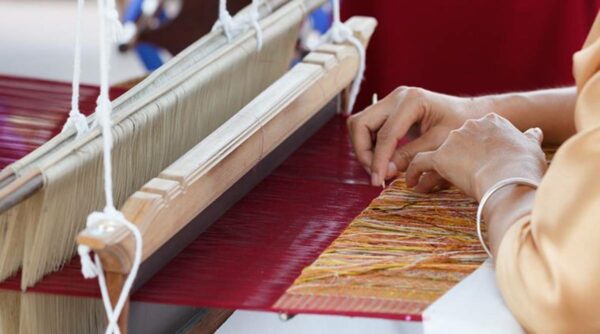
In the present era of synthetic fabrics which mostly owe their origin to Western Culture, we seldom forget to celebrate our country’s rich fabrics and colourful weaves. With National Handloom Day around the corner, let’s delve into the rich history of our handloom.
History Of National Handloom Day
With the declaration of the Bengal partition by Lord Curzon, the Swadeshi Movement expanded and acquired fame. In 1905, August 7 a formal pledge was adopted at the Calcutta Town Hall to absolutely boycott the use of foreign products and shift to Indian-made products. After 100 yers later, in 2015, our respected Prime Minister Narendra Modi inaugurated the first National Handloom Day. It was a method to express gratitude to the weavers and others associated with the handloom industry and to promote handwoven amaterials. It was laundhed to generate awareness among the Indians about the sinking handloom industry.
National Handloom Day significance

In India, the textile sector and the handloom sector constitues the second-largest medium of employment to people second to the agriculture sector. It includes the works from the plain looms to the decorations done post-loom like the sarees, scarves, carpets, shawls, dhurries, angocha/gamcha, towels, the traditional ‘angavastrams’, and dress materials. By the datas provided in the Fourth All India Handloom Census, households that are associated with handloom and weaving related activities numbered 31.45 lakh. Not only that, 70 per cent of the handloom workers (specially weavers) are women, hence it functions as an important resource to women empowerment.
What is handloom?

India has the largest and widespread weaving industry in the world. They range from Benarasi brocades of Uttar Pradesh to Tamil Nadu’s famous Kanchipuram sarees and from Maharashtra’s Paithani weaves to Assam’s Muga (golden silk) mekhela sadors.
Since the Handloom (Reservation and Articles for Production) Act, 1985, where handloom was defined as “any loom other than power loom”, different definitions have evolved. In recent times the meaning of handloom has become more descriptive. A new definition was put forward in 2012: “Handloom means any loom other than the power loom, and includes any hybrid loom at which at least one process of weaving requires manual intervention or human energy for production.”
The definition indirectly made space for a modified entry for the power loom weavers. Whatsoever, social media campaigns like #vocal4handmade have been in trend with several ministers from the government, celebrities and popular fashion designers advocating the cause.
There was a time maybe a decade ago when in any weaving village at least five looms were present in every home. Today, finding one loom among five households seem to be difficult. There are several reasons why weavers are quitting their traditional work and opting for other means of income.
Increase in cost of Raw Material
According to reports of the Fourth All India Handloom Census (2019-2020), raw material support was required by almost 59.5 per cent of weaver households. Costs of cotton, silk, woollen yarn to dyes have skyrocketed and the shortage has increased. In 2015, concerns were raised by a representation of the Confederation of Indian Textile Industry for insufficiency of cotton for weavers in Maharashtra, Andhra Pradesh and Telangana. Their transportation costs soared because they had to travel far to get cotton. On the other hand, smaller weavers are facing difficulty in buying in bulk because of less capital availability and as a result output of material has decreased significantly.
 Lower Credit Support
Lower Credit Support
According to the records of the Textile Association of India, the budget distribution for the textile sector decreased to Rs 4,831 crore in (2019-20) from Rs 6,943 in the previous financial year. This also implies that several schemes be it subsidies, housing, or health insurance will impact the weavers too. Most of the smaller weavers are living at the mercy of money lenders, and in recent years suicides have made headlines.
Reduced number of weavers
In recent years, many traditional families are migrating to cities for employment, and weavers are leaving their loom behind and shifting to other sources of income. Although last year’s Handloom Census (2019-2020) provides the data that there are almost 31.44 lakh handloom households, and has recorded a rise from 27.83 lakh in the previous census, the numbers are still unsatisfactory. If we compare with 1995-96, the numbers were at 65.51 lakh, we can understand that there has been a massive deterioration in the textile industry.
Lack of access to major markets
Substandard textile infrastructure, outdated looms and inaccessibility to hit major markets have added to the distress of the handloom weavers. Several NGOs have extended a hand to these weavers by helping local communities to reach customers directly. But that alone can’t improve the situation. There is an urgent need to make it a level playing field of weavers of every income group, be it a master weaver with more than 50 people working under him, or a marginal to a smaller weaver, who along with his family members works from home.
Currently, there are almost 13 government schemes for weavers. But, there’s roughly 3 per cent that is aware of the Weaver’s Health Insurance Scheme and less than 11 per cent are aware of the credit waivers for loans that they can get (Handloom Census 2019-2020).
Way Forward
Last year, after the Coronavirus started disrupting the economy, our Prime Minister Shri Narendra Modi launched several campaigns. Among them, the ‘Atmanirbhar Bharat’ programme and the ‘vocal for local’ campaign, along with ‘Make in India‘, offers a huge opportunity to the textile sector (especially the handloom sector) to further solidify the country’s positioning in the global textile market. However, to magnify this, the demand for handloom must increase and that must begin from home itself.
Although the impact and shock waves of the Coronavirus pandemic have had disastrous effects on poor rural and urban livelihoods, the chances of boosting the sector are vast. But, to utilize the opportunities, all stakeholders including the private players must extend a hand.
Several initiatives such as the Northeast Expo 2019 under the umbrella of ‘tea and khadi’ diplomacy must be continued through digital platforms. The initiative offered a platform to the eight northeastern states through ‘Tea and Khadi’ diplomacy advancing trade relations with the ASEAN and BIMSTE countries. Since physical markets are yet to operate fully due to the pandemic, this moment should be utilized by the state and central government to create more and more digital market platforms for Indian handloom, forest produce and handicrafts because all these three sectors are interlinked.
On top of that, it also offers an opportunity for the sectors to teach Self Help Group (SHG) members in digital techniques. This would be different from the regular financial literacy and marketing operation in capacity building. It is also important for the weavers and artisans to get accustomed to operating online platforms and for that proper training should be provided. Indian embassies can play a significant role in promoting Indian handicrafts. They can hold online exhibitions to introduce the global audience to the rich cultural legacy of the handlooms.
Few days before the lockdown in 2020, in the UK, an exhibition was organized under the aegis “Forgotten Masters: Indian Painting for the East India Company”, to honour and pay tribute to the painters from India. This must be taken as an example and more such exhibitions must be organized.
We can celebrate National Handloom Day in true spirit only after we can rescue the weavers from their present condition. This can be done by generating awareness, accessibility to markets and design Research and Development, easy availability of raw materials and better credit support.
Edited by Aishwarya Ingle



